2012 RENAULT CLIO SPORT TOURER light
[x] Cancel search: lightPage 36 of 264
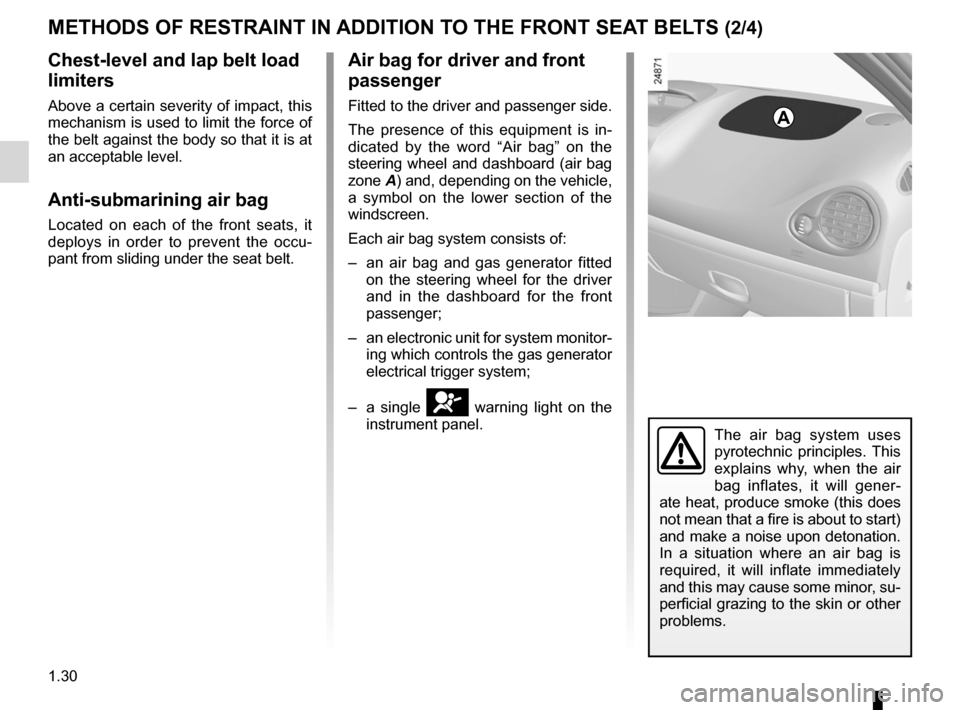
1.30
ENG_UD19771_3
Dispositifs complémentaires à la ceinture avant (X85 - B85 - C85 \
- S85 - K85 - Renault)
ENG_NU_853-8_BCSK85_Renault_1
Jaune NoirNoir texte
Chest-level and lap belt load
limiters
Above a certain severity of impact, this
mechanism is used to limit the force of
the belt against the body so that it is at
an acceptable level.
Anti-submarining air bag
Located on each of the front seats, it
deploys in order to prevent the occu -
pant from sliding under the seat belt.
Air bag for driver and front
passenger
Fitted to the driver and passenger side.
The presence of this equipment is in -
dicated by the word “Air bag” on the
steering wheel and dashboard (air bag
zone A) and, depending on the vehicle,
a symbol on the lower section of the
windscreen.
Each air bag system consists of:
– an air bag and gas generator fitted
on the steering wheel for the driver
and in the dashboard for the front
passenger;
– an electronic unit for system monitor-
ing which controls the gas generator
electrical trigger system;
– a single
å warning light on the
instrument panel.
METHODS OF RESTRAINT IN ADDITION TO THE FRONT SEAT BELTS (2/4)
A
The air bag system uses
pyrotechnic principles. This
explains why, when the air
bag inflates, it will gener -
ate heat, produce smoke (this does
not mean that a fire is about to start)
and make a noise upon detonation.
In a situation where an air bag is
required, it will inflate immediately
and this may cause some minor, su-
perficial grazing to the skin or other
problems.
Page 37 of 264
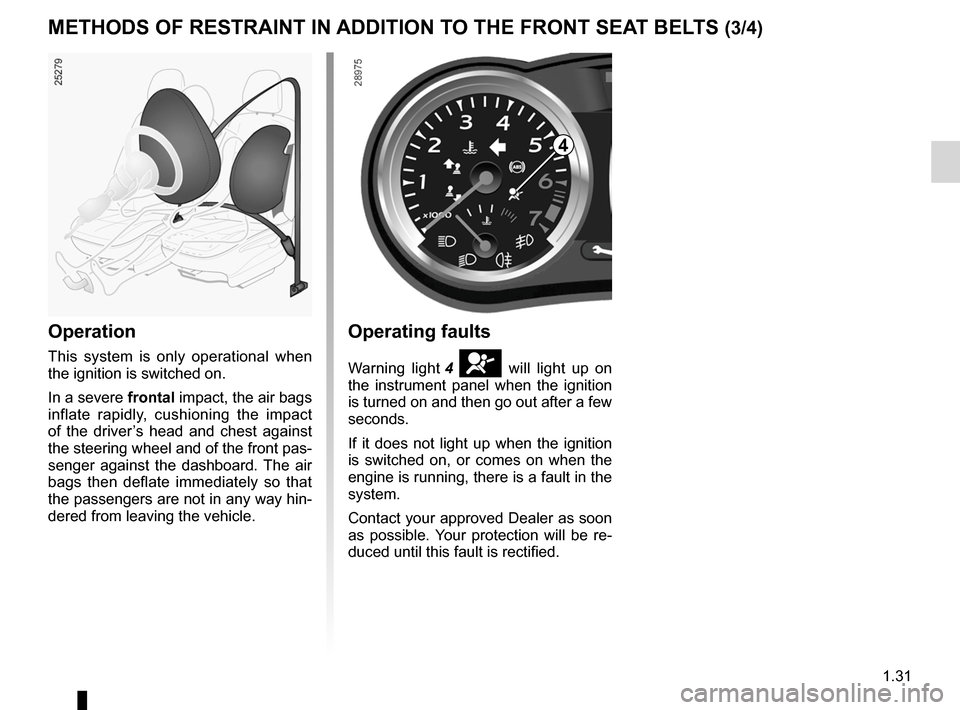
JauneNoirNoir texte
1.31
ENG_UD19771_3
Dispositifs complémentaires à la ceinture avant (X85 - B85 - C85 \
- S85 - K85 - Renault)
ENG_NU_853-8_BCSK85_Renault_1
METHODS OF RESTRAINT IN ADDITION TO THE FRONT SEAT BELTS (3/4)
Operating faults
Warning light 4 å will light up on
the instrument panel when the ignition
is turned on and then go out after a few
seconds.
If it does not light up when the ignition
is switched on, or comes on when the
engine is running, there is a fault in the
system.
Contact your approved Dealer as soon
as possible. Your protection will be re-
duced until this fault is rectified.
4
Operation
This system is only operational when
the ignition is switched on.
In a severe frontal impact, the air bags
inflate rapidly, cushioning the impact
of the driver’s head and chest against
the steering wheel and of the front pas-
senger against the dashboard. The air
bags then deflate immediately so that
the passengers are not in any way hin-
dered from leaving the vehicle.
Page 38 of 264

child safety............................................................. (current page)
1.32
ENG_UD19771_3
Dispositifs complémentaires à la ceinture avant (X85 - B85 - C85 \
- S85 - K85 - Renault)
ENG_NU_853-8_BCSK85_Renault_1
METHODS OF RESTRAINT IN ADDITION TO THE FRONT SEAT BELTS (4/4)
Warnings concerning the driver’s air bag
– Do not modify the steering wheel or the steering wheel boss.
– Do not cover the steering wheel boss under any circumstances.
– Do not attach any objects (badge, logo, clock, telephone holder, etc.) to the steering wheel boss.
– The steering wheel must not be removed (except by qualified personnel from our Network).
– When driving, do not sit too close to the steering wheel. Sit with your arms slightly bent (see the information on “Adjusting
your driving position” in Section 1). This will allow sufficient space for the air bag to deploy correctly and be fully effective.
Warnings concerning the passenger air bag
– Do not attach or glue any objects (badge, logo, clock, telephone holder, etc.) to the dashboard on or near the air bag.
– Do not place anything between the dashboard and the passenger (pet, umbrella, walking stick, parcels, etc.).
– The passenger must not put his or her feet on the dashboard or seat as there is a risk that serious injuries may occur. In
general, parts of the body should be kept away from the dashboard (knee\
s, hands, head, etc.).
– The devices in addition to the front passenger seat belt should be reactivated as soon as a child seat is removed, to ensure
the protection of the passenger in the event of an impact.
A REAR-FACING CHILD SEAT MUST NOT BE FITTED TO THE FRONT PASSENGER SEAT UNLESS THE ADDITIONAL RESTRAINT SYSTEMS, I.E. THE PASSENGER AIR BAG, ARE DEACTIVATED.
(refer to the information on “Child safety: deactivating/activating \
the front passenger air bag” in Section 1)
Warnings concerning the anti-submarining air bag
Do not let a child under the age of 12 sit in this seat. When triggered, the anti-submarining air bag may project objects left on
the seat base with a great deal of force.
Risk of serious injury.
All of the warnings below are given so that the air bag is not obstructed in any way when it is inflated and also to prevent
the risk of serious injuries caused by items which may be dislodged when\
it inflates.
Page 51 of 264
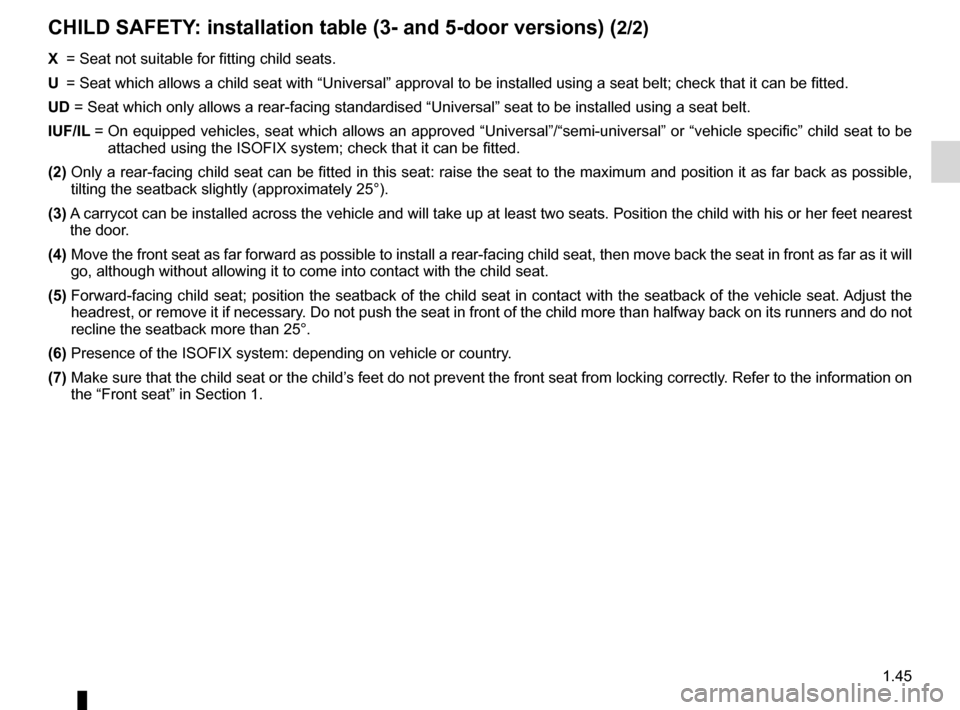
JauneNoirNoir texte
1.45
ENG_UD24917_5
Sécurité enfants : installation du siège enfant (X85 - B85 - C\
85 - S85 - K85 - Renault)
ENG_NU_853-8_BCSK85_Renault_1
CHILD SAFETY : installation table (3- and 5-door versions) (2/2)
X = Seat not suitable for fitting child seats.
U = Seat which allows a child seat with “Universal” approval to be installed using a seat belt; check that it can be fitted.
UD = Seat which only allows a rear-facing standardised “Universal” seat\
to be installed using a seat belt.
IUF/IL = On equipped vehicles, seat which allows an approved “Universal”/“semi-universal” or “vehicle specific” child seat to be
attached using the ISOFIX system; check that it can be fitted.
(2) Only a rear-facing child seat can be fitted in this seat: raise the seat to the maximum and position it as far back as possible,
tilting the seatback slightly (approximately 25°).
(3) A carrycot can be installed across the vehicle and will take up at least two seats. Position the child with his or her feet nearest
the door.
(4) Move the front seat as far forward as possible to install a rear-facing child seat, then move back the seat in front as far as it will
go, although without allowing it to come into contact with the child sea\
t.
(5) Forward-facing child seat; position the seatback of the child seat in contact with the seatback of the vehicle seat. Adjust the
headrest, or remove it if necessary. Do not push the seat in front of the child more than halfway back on its runners and do not
recline the seatback more than 25°.
(6) Presence of the ISOFIX system: depending on vehicle or country.
(7) Make sure that the child seat or the child’s feet do not prevent the front seat from locking correctly. Refer to the information on
the “Front seat” in Section 1.
Page 53 of 264
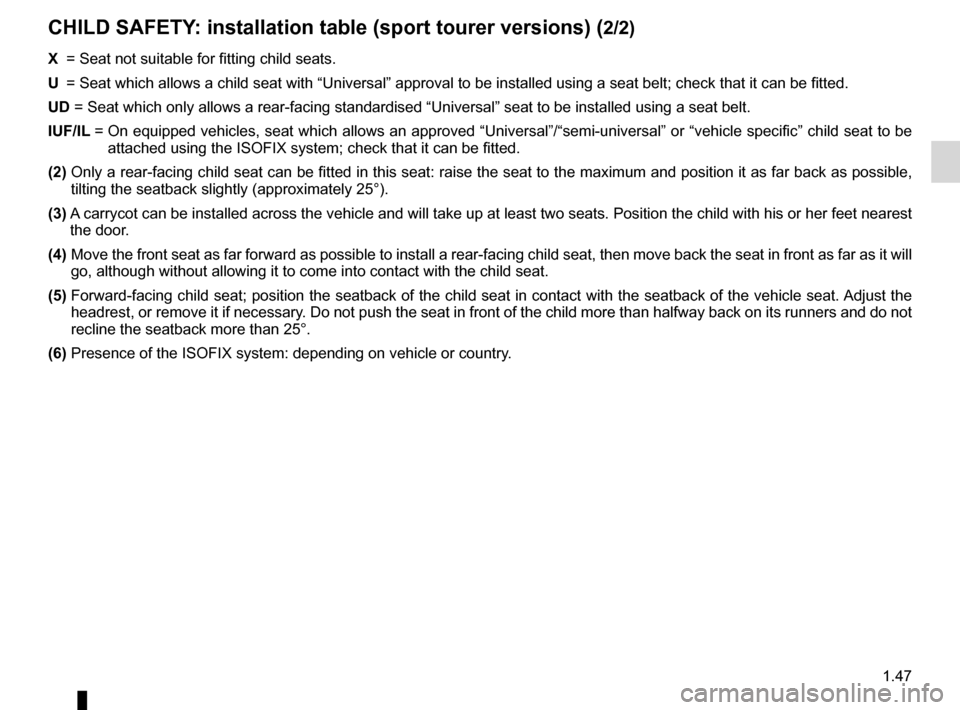
JauneNoirNoir texte
1.47
ENG_UD24917_5
Sécurité enfants : installation du siège enfant (X85 - B85 - C\
85 - S85 - K85 - Renault)
ENG_NU_853-8_BCSK85_Renault_1
CHILD SAFETY : installation table (sport tourer versions) (2/2)
X = Seat not suitable for fitting child seats.
U = Seat which allows a child seat with “Universal” approval to be installed using a seat belt; check that it can be fitted.
UD = Seat which only allows a rear-facing standardised “Universal” seat\
to be installed using a seat belt.
IUF/IL = On equipped vehicles, seat which allows an approved “Universal”/“semi-universal” or “vehicle specific” child seat to be
attached using the ISOFIX system; check that it can be fitted.
(2) Only a rear-facing child seat can be fitted in this seat: raise the seat to the maximum and position it as far back as possible,
tilting the seatback slightly (approximately 25°).
(3) A carrycot can be installed across the vehicle and will take up at least two seats. Position the child with his or her feet nearest
the door.
(4) Move the front seat as far forward as possible to install a rear-facing child seat, then move back the seat in front as far as it will
go, although without allowing it to come into contact with the child sea\
t.
(5) Forward-facing child seat; position the seatback of the child seat in contact with the seatback of the vehicle seat. Adjust the
headrest, or remove it if necessary. Do not push the seat in front of the child more than halfway back on its runners and do not
recline the seatback more than 25°.
(6) Presence of the ISOFIX system: depending on vehicle or country.
Page 54 of 264
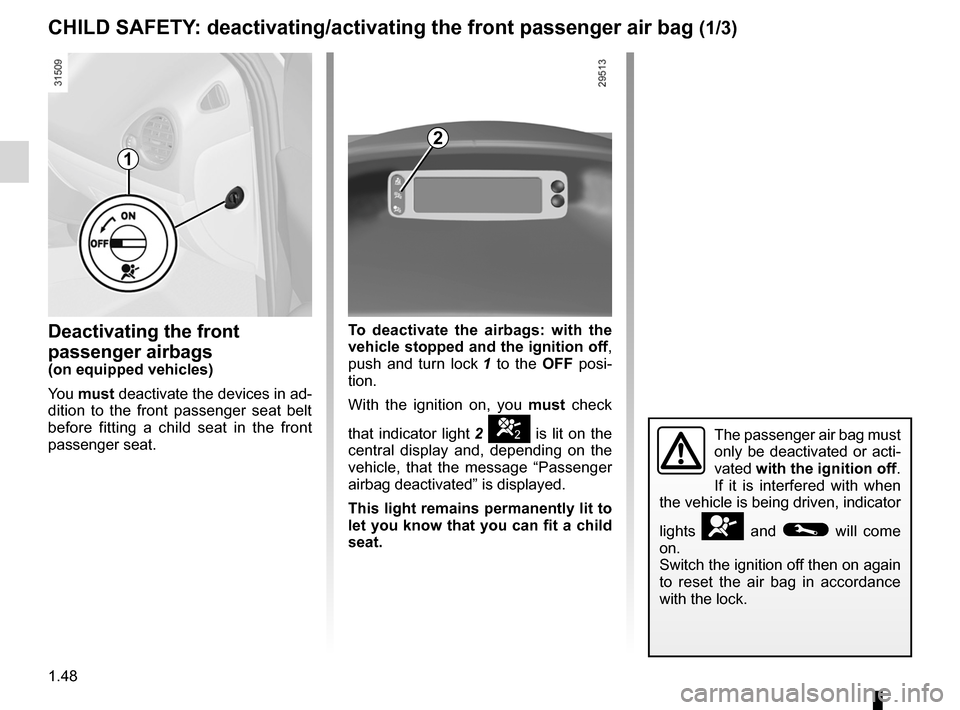
air bagdeactivating the front passenger air bags ........ (current page)
front passenger air bag deactivation ..................... (current page)
child restraint/seat ................................................. (current page)
child safety ............................................................. (current page)
child restraint/seat ................................................. (current page)
transporting children .............................................. (current page)
1.48
ENG_UD19903_3
Sécurité enfants : désactivation/activation airbag passager ava\
nt (X85 - B85 - C85 - S85 - K85 - Renault)
ENG_NU_853-8_BCSK85_Renault_1
Jaune NoirNoir texte
Deactivating and activating the front passenger airbag
CHILD SAFETY : deactivating/activating the front passenger air bag (1/3)
Deactivating the front
passenger airbags
(on equipped vehicles)
You must deactivate the devices in ad-
dition to the front passenger seat belt
before fitting a child seat in the front
passenger seat. To deactivate the
airbags: with the
vehicle stopped and the ignition off,
push and turn lock 1 to the OFF posi -
tion.
With the ignition on, you must check
that indicator light 2
] is lit on the
central display and, depending on the
vehicle, that the message “Passenger
airbag deactivated” is displayed.
This light remains permanently lit to
let you know that you can fit a child
seat.
1
2
The passenger air bag must
only be deactivated or acti-
vated with the ignition off.
If it is interfered with when
the vehicle is being driven, indicator
lights
å and © will come
on.
Switch the ignition off then on again
to reset the air bag in accordance
with the lock.
Page 56 of 264
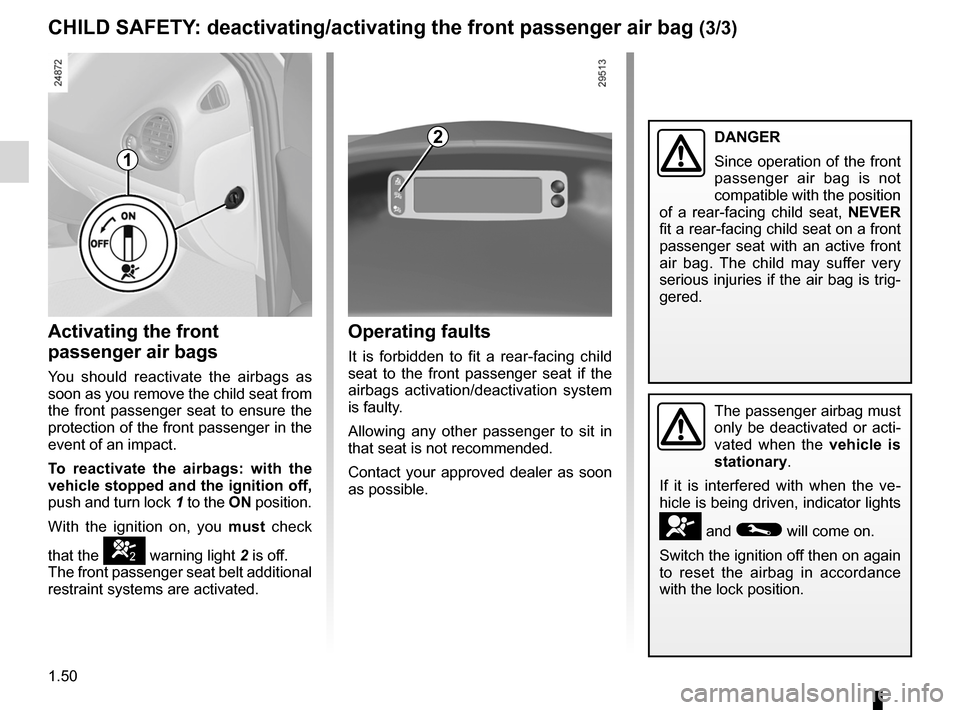
air bagactivating the front passenger air bags ............ (current page)
1.50
ENG_UD19903_3
Sécurité enfants : désactivation/activation airbag passager ava\
nt (X85 - B85 - C85 - S85 - K85 - Renault)
ENG_NU_853-8_BCSK85_Renault_1
CHILD SAFETY : deactivating/activating the front passenger air bag (3/3)
Activating the front
passenger air bags
You should reactivate the airbags as
soon as you remove the child seat from
the front passenger seat to ensure the
protection of the front passenger in the
event of an impact.
To reactivate the airbags: with the
vehicle stopped and the ignition off,
push and turn lock 1 to the ON position.
With the ignition on, you must check
that the
] warning light 2 is off.
The front passenger seat belt additional
restraint systems are activated.
Operating faults
It is forbidden to fit a rear-facing child
seat to the front passenger seat if the
airbags activation/deactivation system
is faulty.
Allowing any other passenger to sit in
that seat is not recommended.
Contact your approved dealer as soon
as possible.
The passenger airbag must
only be deactivated or acti-
vated when the vehicle is
stationary.
If it is interfered with when the ve -
hicle is being driven, indicator lights
å and © will come on.
Switch the ignition off then on again
to reset the airbag in accordance
with the lock position.
1
2DANGER
Since operation of the front
passenger air bag is not
compatible with the position
of a rear-facing child seat, NEVER
fit a rear-facing child seat on a front
passenger seat with an active front
air bag. The child may suffer very
serious injuries if the air bag is trig-
gered.
Page 57 of 264
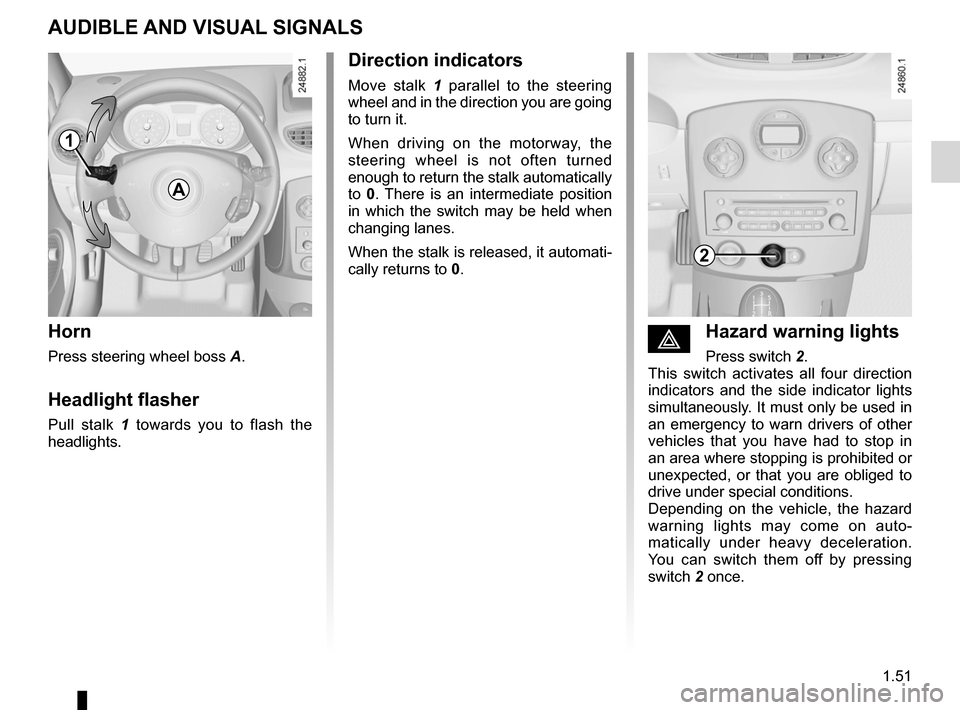
audible and visual signals.....................(up to the end of the DU)
indicators .............................................. (up to the end of the DU)
lighting: exterior ............................................ (up to the end of the DU)
lights: hazard warning ............................... (up to the end of the DU)
indicators: direction indicators .......................... (up to the end of the DU)
hazard warning lights signal ................. (up to the end of the DU)
signals and lights .................................. (up to the end of the DU)
hazard warning lights signal ................. (up to the end of the DU)
lights: direction indicators .......................... (up to the end of the DU)
horn ...................................................... (up to the end of the DU)
1.51
ENG_UD19905_2
Avertisseurs sonores et lumineux (X85 - B85 - C85 - S85 - K85 - Renault)\
ENG_NU_853-8_BCSK85_Renault_1
Audible and visual signals
éHazard warning lights
Press switch 2.
This switch activates all four direction
indicators and the side indicator lights
simultaneously. It must only be used in
an emergency to warn drivers of other
vehicles that you have had to stop in
an area where stopping is prohibited or
unexpected, or that you are obliged to
drive under special conditions.
Depending on the vehicle, the hazard
warning lights may come on auto -
matically under heavy deceleration.
You can switch them off by pressing
switch 2 once.
Direction indicators
Move stalk 1 parallel to the steering
wheel and in the direction you are going
to turn it.
When driving on the motorway, the
steering wheel is not often turned
enough to return the stalk automatically
to 0. There is an intermediate position
in which the switch may be held when
changing lanes.
When the stalk is released, it automati-
cally returns to 0.
Horn
Press steering wheel boss A.
Headlight flasher
Pull stalk 1 towards you to flash the
headlights.
AUDIBLE AND VISUAL SIGNALS
A
2
1